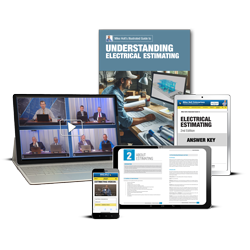Estimating software does not eliminate the need to learn how to estimate. Using software can make a
good estimator far more effective, by eliminating human error. Reduced error results in reduced risk and an opportunity to
make more money! But an unskilled estimator is still going to do a poor job of estimating, regardless of whether or not
estimating software is used.
Some advantages and benefits of software versus the manual method include:
Accuracy
Software can help improve accuracy quite a bit, particularly during the extension phase of your estimates. The computer does the
calculations with more accuracy and speed than any human (or even a large group of humans) ever could. If something changes or a
mistake is found, it is much easier to make the necessary corrections and redo the extensions. But if you do not enter the data
for your estimate accurately, you will not have an accurate bid. If you succeed in accurate count and entry, your estimates should
be more complete than any done manually.
Confidence
A computer-assisted estimate provides increased confidence that the bid price is correct. It also provides more
consistent and accurate historical data for future jobs of the same type. Tapping even a little of its potential
will improve your competitiveness and increase your profit margins.
Increased profitably
The savings in estimating time will permit you to estimate more jobs. That, in turn, will allow you to expand business volume.
Increasing volume, in itself, is not always good. Increasing the volume of profitable jobs is the real goal, and good software
can help you do that.
Marketing
Computer-assisted estimates can improve your marketing program and sales efforts because they can provide you with a more detailed
and professional looking package to present to customers. This, however, is only the beginning of what you can do. You can provide a
level of detail that shows what is actually required to complete the job, along with price breakdowns that show lowball bids cannot
be taken seriously. Yes, you will still be competing with any bidders that also prepare an accurate estimate. But that is really what
the bidding process is supposed to achieve in the first place.
Material Cost Control
Once the takeoff is complete and you have entered the quantities, you can easily generate a report of all the material required for
the job. You can generate a summary, or a report broken down by job phase or type of materials. You can then e-mail this to multiple
suppliers to obtain competitive prices and fixed delivery dates. You can also share the estimate with a contractor's purchasing and
accounting departments. Cost tracking and inventory control become much simpler when you use software to generate and control the
information. Material prices can be changed easily, quickly, and accurately at the last minute. You can make information secure and
easier to retrieve with various search criteria specific to what you are looking for.
Project Managmement Efficiency
If integrated properly with the project management system, estimating software provides the flexibility to track projects in many
ways, such as by system, floor, building, site, or project phase. A project manager can make a few mouse clicks to update the Work
Breakdown Structure, Critical Path, Gant Chart, and other key project management items in real time. It is easy to share information
with people in the field.
Reduced Overhead
A computer-based estimating system allows an estimator to bid on more jobs in the same amount of time, reducing estimating costs per
bid relative to revenue. Material inventory control improves with accurate and available reports, providing such benefits as reduced
costs for storage space and financing. You can also improve billing and expedite collections. You vastly reduce the investment in
office space and filing cabinets, while reducing the fire fuel load that comes with storing large quantities of paper.
Time Savings
A computer does thousands of mathematical computations in a fraction of a second, never makes a mathematical error, never becomes
tired or careless, and never forgets. Estimating software reduces estimating time and costs, partly because you no longer need to
price, labor, extend, or total material and labor manually.The amount of time saved depends on the software, the estimator, and the
complexity of the jobs being estimated. As a general rule, once you are proficient with the software, you should be able to complete
a computerized estimate in 25 percent of the time that it will take you to do one manually.
The key to success in software-based estimating is taking the time to select software that meets
your needs.
Aspects
Usability. Software should be logical, intuitive,
simple to use,
flexible, and easy to understand. It should provide an on-screen audit trail to
review and modify the take-off at any time.
Flexibility. It should provide the capability of
factoring labor
and/or material cost for every line of the take-off to reflect diverse
installation conditions. You should be able to view or change anything in the
estimate at any point easily and quickly.
Reports. The system should provide for a permanent
audit trail
that tracks the input. When looking at software options, pay close attention to
the types of reports it will allow you to generate. You need reports that
support your business processes. Determine what kinds of reports you need before
you even look at estimating software.
Integration. Integration with your accounting system.
Is that
important?
Your Needs. Are you a small contractor just opening your
business, or do you have a large company that has been in business for several
years? Some software is more suitable for the former while others are more
suitable for the latter. Take this into consideration during your search.
Remember that you can always move up to a more sophisticated product when sales
improve; sometimes even with the same vendor.
Cost
It is tempting to save money on estimating software, rejecting anything over a certain price level.
If it does not meet your needs, then the low-priced purchase is a waste of money. This kind of cost savings can
actually be expensive in the long run. Instead, determine what your current and anticipated needs are, and then look at
all of the software that meets those needs.
To determine the dollars required in sales to cover the purchase of estimating software, use the following formula:
Sales Increase Required per Year = Software Cost/Gross Profit
Percent
Example: How much must sales increase per year to cover the cost of an
estimating system, based on the following factors? It includes software,
computer, and training$6,000; gross profit margin of 40 percent, with
expected life of four years.
Sales = Cost per Year/Gross Profit Percent
Cost per Year = $6,000/4 years
Cost per Year = $1,500
Sales Required per Year = $1,500/40%
Sales Increase Required per Year = $3,750
With vendors that offer multiple versions or levels of estimating software, evaluate whether or not your data can
migrate to an upgraded system later on, should you choose to purchase one of the lower priced versions.
Hardware
Do not make the mistake of trying to use an old, outdated computer to run new, super-charged software. Doing so will result in
frustration and disappointment. Besides that, you will not receive the most from your investment. How do you know if the hardware
is outdated? If you are spending time waiting for the computer instead of getting work done, you need to upgrade.
If the computer is waiting on you instead of the other way around, then the fact that the computer is not very new may not matter.
But, if you have an older computer, be sure the software you are considering will work with the operating system it uses. Stay up to
date with your hardware. Computers typically have a higher failure rate after two to three years of use. Purchase something that
will handle the software you select without a lot of effort. The software vendor you select can often suggest a good machine that
meets their requirements.
Because of the technical nature of electrical estimating, only a person who has been trained in electrical contracting can adequately
explain how computerized estimating works, and the many ways it will benefit you. Take your time to investigate the different vendors
and make a selection based on facts, not opinions. If possible, see if you can use the software on a trial basis. Naturally this will
cost you a few hundred dollars; insist on money back guarantee.
Due diligence
Find out as much as you can about the software vendor:
- How long have they been in the business of selling software?
- How many customers do they have?
- What other software products do they sell?
- What is their background in estimating and electrical contracting?
- Get references. Ask the vendor for a list of their users, then follow up by calling a few and
asking how satisfied they are. Be sure to talk to at least one user who is similar in size to
your company and does work similar to yours.
Set Up and Training
Once you have selected a software and before you start entering data, you need to learn to use it! Training can require hours to
days, so take the time to carefully select the right software and the right software vendor to partner with.
Regardless of how well estimating software is designed, do not expect optimum results without complete training.
During your negotiations with the software vendor, ask if they will provide the training necessary at no additional cost.
Some will, others will not—but it never hurts to ask!
Technical Support
Software is not a one-time expense; it carries a continuous cost for annual support. Be sure you can count on long-term service from
the company and that they will give you close personal attention. Verify the costs for customer support and the hours they are
available for phone and/or e-mail support. If you are going to have multiple systems, or have a multi-user network version, find out
if it will be a single location or "per seat" annual fee. These fees and services can cost as much as a single-user license but can
pay for themselves over the course of a year.
Material Pricing Services
To use estimating software most effectively, you need to subscribe to a material pricing service to gain assurance you have the most
current material prices. These programs interface with most major estimating software programs and can price almost all the
individual material items in the database. If you decide to use a pricing service:
- Verify that prices accurately reflect prices where your job is located
- Research reviews of the companies offering pricing services
- Ask where they obtain their material prices
- Find out their relationship to the electrical industry
- Get some references
Keep in mind that pricing services cannot keep up with the constantly changing conduit and wire prices, so you must check the prices
for these items for each bid—especially when large quantities are included in the estimate.
If you decide you do not want to use a pricing service, you will most likely need to create material reports for your vendors to price
out every estimate you do. This may add to your workload and will make you dependent on your vendors for service. Check with your
electrical distributor and key vendors to see what pricing services they provide as well.







